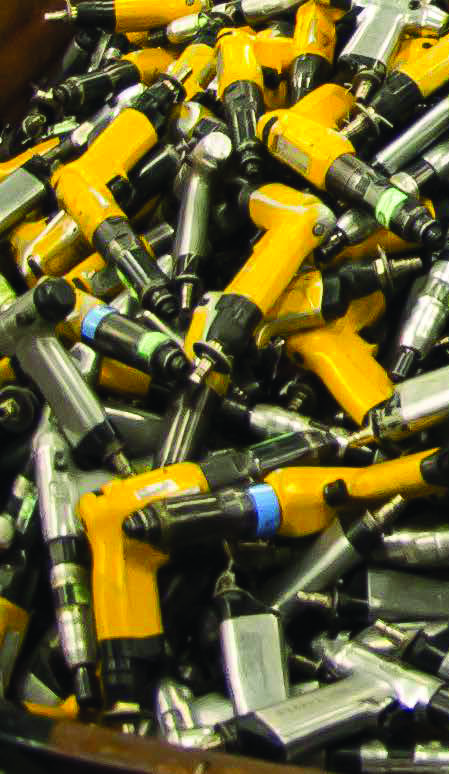Tuning Tools
Predicting when tools need calibrating improves quality — and saves rework and money
By Eric Fetters-Walp, Boeing

By Eric Fetters-Walp, Boeing
Boeing jetliners are packed with high technology and cutting-edge design, but it still takes torque wrenches, screw guns and other relatively low-tech tools to put them together—along with mechanics who use the tools.
And the quality of Boeing products depends, in part, on making sure these tools are properly maintained. On the 787 program, for example, 57 different tools that are especially critical to the final assembly of the Dreamliner are calibrated every three to four days to minimize tool-related risks. While inspectors and extensive Quality Assurance processes catch work performed with tools out of calibration, preventing it from happening saves time and money.
To that end, teams in Commercial Airplanes and Engineering, Operations & Technology have developed a predictive analytics program to keep tools better calibrated and working well, which prevents costly rework that can slow production. In less than a year, the program has identified dozens of “significantly out of tolerance” (commonly referred to as SOOT) tools in Boeing’s factories and helped predict when others need to be calibrated.
“By applying the analytics model, we were able to ‘pull ahead’ a number of our out-of-tolerance tools that would have taken months to find,” said Martin Ohman, SOOT mitigation leader for Fabrication. “This saved the programs potentially millions of dollars in rework Predicting when tools need calibrating improves quality – and saves rework and money tools if the tools had been used to their full calibration cycle.”

The program analyzes rafts of data on the tools—how they are used and when they are prone to slip out of calibration or just wear out. In simpler terms, it builds on a concept that has proved successful in Major League Baseball. The book and film Moneyball tell the story of how the Oakland Athletics’ general manager used empirical analysis of player statistics, especially statistics and data patterns that previously were undervalued by other teams, to predict a player’s future performance. The Athletics have built winning teams as a result.
Boeing continues to expand its use of predictive and other advanced analytics into new areas where they might be useful, explained Paul Ortman, Manufacturing Operations Advanced Analytics manager in Commercial Airplanes. Boeing has reams of data available, and within Commercial Airplanes, it is his team’s job to figure out how to use it productively. His team worked with an Information Technology team in Huntington Beach, Calif., to create and apply specialized analytic formulas. “They previously had no way to proactively prevent SOOTs before they happened,” said Melanie Lorang, Associate Technical Fellow and Product System Analytics program manager in Huntington Beach. “They only could see what happened and eliminate the problem tools after the fact.”
Using tools that are beyond their safe tolerance range can require rework on parts of the airplane that were touched by those tools, potentially causing expensive production rework and delays for customers. It’s happened before, said Steve Onustack, senior manager of the Metrology Lab Operations in the Puget Sound region. Metrology employees, part of Boeing Test & Evaluation, are tasked with making sure Boeing’s tools stay calibrated.

Lorang and the project’s primary IT data specialist, Irene Umamoto, along with statistician and Associate Technical Fellow Bob MacLean and Aviana Global Technologies consultant James Bettles, combined their specialties in designing a computer program specifically for predicting out-of-tolerance tools. While using predictive mathematical formulas and computer programs has boomed in a number of industries in recent years, MacLean has worked with predictive models since the 1970s. The main difference is that today’s technology makes it easier to harness facts and figures into useable prediction tools.
Ortman and the lead analyst on his team, Alan Davis, led implementation of the analytics software at Commercial Airplanes sites. It quickly made a difference, they said. For example, one torque wrench that was taken out of service in Renton, Wash., after it was identified as being out of tolerance would have stayed on the factory floor for up to a year under the old re-calibration schedule. In all, more than 40 SOOT tools were discovered and a significant number of less seriously out-of-tolerance tools were discovered as well, Ortman and Davis explained.
Using the predictive software program and its findings has led the Metrology team to help mechanics calibrate their tools more often than before, Onustack said. At the same time, there is a related effort to remove more than 13,500 older tools, which are at greater risk for creating tolerance problems, from Commercial Airplanes factories by the summer.
“Right now, we’re choosing to err on the side of reducing risk as much as possible,” Onustack said, adding that the Metrology team has developed other tools to help users identify specific poor-performing tools so they can remove them from service. Also, commonality among tools is increasing, and the company is planning to place torquechecking devices closer to mechanics’ work areas at Commercial Airplanes sites.
Meanwhile, Lorang’s team is trying to make this project repeatable throughout Boeing’s businesses. Commercial Airplanes is sharing what it has learned as well, Ohman said.
“Our SOOT team is working on making analytics a per-manent part of the tool management system,” Ohman said, “and we are also sharing our discovery with Boeing Defense, Space & Security to see if they may be able to benefit from the use of advanced analytics.”
As Commercial Airplanes sites from Everett, Wash., to Salt Lake City to North Charleston, S.C., use the predictive pro-gram to find problem tools, more information is gathered, Ortman added.
“As we discover new insights, we can add substantial new data to fine-tune this,” he said. “All signs point to this being the right thing to do for the business. We’re remedy-ing the potential for damage and reputational risk by doing this.” – eric.c.fetters-walp@boeing.com